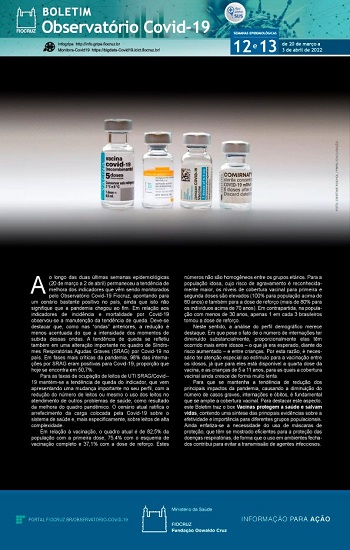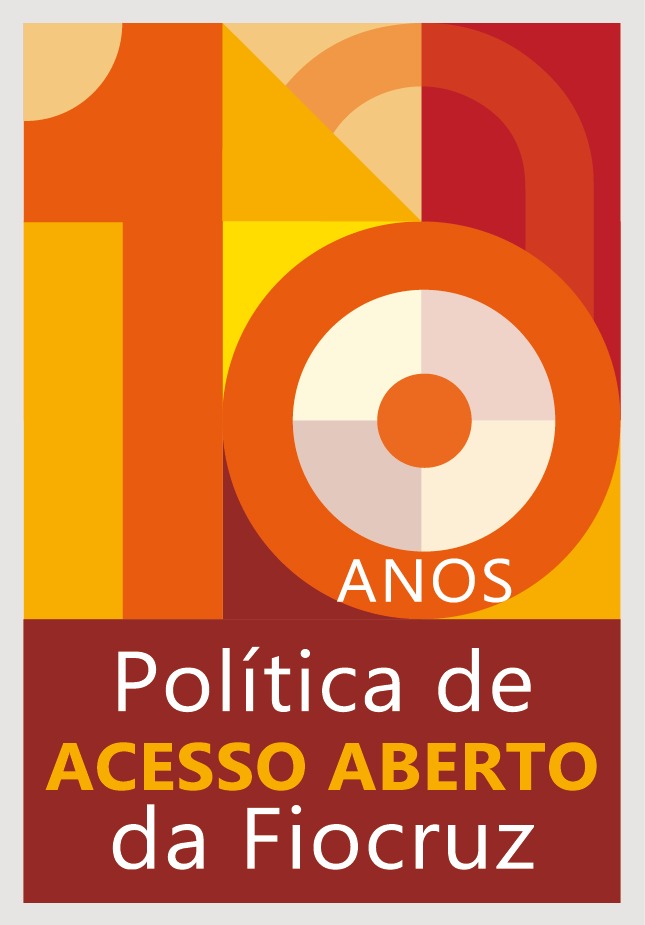COVID-19 Observatory points to a phase of extinction of the third wave in Brazil
12/04/2022
Regina Castro and Ricardo Valverde (Fiocruz News Agency)
 Released this Friday (April 4), the Fiocruz COVID-19 Observatory Report shows maintenance of the falling trend of COVID-19 incidence and mortality indicators. The document highlights that for the first time since May 2020, no Brazilian state has exceeded 0.3 deaths per 100,000 inhabitants. The researchers state that according to these new data it is possible to say that the third epidemic wave in Brazil, with a predominance of Omicron among the cases, is on a path to extinction.
Released this Friday (April 4), the Fiocruz COVID-19 Observatory Report shows maintenance of the falling trend of COVID-19 incidence and mortality indicators. The document highlights that for the first time since May 2020, no Brazilian state has exceeded 0.3 deaths per 100,000 inhabitants. The researchers state that according to these new data it is possible to say that the third epidemic wave in Brazil, with a predominance of Omicron among the cases, is on a path to extinction.
The current scenario signals a gradual reduction of the main impacts of the pandemic, with a reduction in the number of severe cases, hospitalizations, and deaths. However, the scientists warn that this does not mean the pandemic is over, and the situation may change if appear new variants that are more lethal or that escape the immunity provided by COVID-19 vaccines. The analysis refers to Epidemiological Weeks (EW) 12 and 13 of 2022, covering the period between March 20 and April 2.
This drop is also reflected in cases of Severe Acute Respiratory Syndrome (SARS) due to COVID-19. During the most critical phases of the pandemic, 98% of the hospitalizations due to SARS were positive for COVID-19. This rate is currently 50.7%. Another strategic indicator, the lethality rate of COVID-19 has remained around 0.8%.
Over 2021, according to the Bulletin, these rates oscillated between 2 and 3%. They dropped to 0.2% early in 2022 and rose again to 1% in March. The reduction of this indicator, observed during the third pandemic wave, is mainly attributed to the vaccination of most of the target population and to the lower severity of infection by Omicron.
The Report highlights the role played by vaccination in the control of COVID-19, and has a box called "Vaccines Protect Health and Save Lifes" on this subject, addressing the importance of the second and third doses. “In addition, booster shots given to the most vulnerable populational groups can further reduce the impact of the pandemic on mortality and hospitalizations”, the researchers observed. In a continent-sized country such as Brazil, with remarkable differences between its regions, they defend a further expansion of vaccination so as to reach regions with lower coverage. They also point to the need to continue wearing masks indoors.
Another strategic challenge, according to the analysis, is readapting the health system. The idea is to use this period of lower COVID-19 transmission to meet the backlog demands - other cases accumulated when COVID-19 cases were very high. Among the suggested initiatives are also professional training for surveillance and care, strengthening primary healthcare, and care for post-COVID syndromes.
The current phase shows a rejuvenated pandemic, following a new pattern beginning at the base of the pyramid, and not at the top. The average age of hospitalizations and deaths has been falling significantly. The median of hospitalizations has also dropped in the past two weeks: the average age of hospitalizations is now remaining below 60. During EW 12, half of the hospitalizations involved people about 67 years old (clinical and ICU beds). As for deaths, half the events involved people at least 74 years old.
Genomic Network points to an increase in the BA.2 lineage
In another front and data analysis, Fiocruz’s Genomic Network published last Friday (April 8) an update of the data obtained from the surveillance regarding the lineages and variants of the Sars-CoV-2 in Brazil. According to the data gathered by the Network, the Omicron variant has completely replaced the Delta in Brazil. There has also been a trend of increased frequency of BA.2, something that had previously been observed in the US and in some European countries.
In February, BA.2 was responsible for 1.1% of the genomes. In March, this rate had jumped to 3.4%. Up to the date on which this update was wrapped up, in Brazil only lineages BA.1 (19,555 genomes), BA.1.1 (4,290 genomes), and BA.2 (151 genomes) had been identified. However, the researchers say that more data are needed to confirm this process. The figures also show that the North Region showed a delayed growth of the Omicron trend, which not completely dominates the epidemiological scenario of COVID-19 in Brazil.
During these 14 days (between March 18 and March 31), the Laboratory of Measles and Respiratory Viruses of the Oswaldo Cruz Institute (IOC/Fiocruz) and five other Fiocruz units, in the states of Amazonas, Ceará, Pernambuco, Paraná and Bahia, produced 1.766 genomes. Each of Fiocruz’s sequencing units (in addition to the already mentioned ones there is also one in Piauí and another in Minas Gerais) covers one or more Brazilian states. During this period, on April 4, the Fiocruz Genomic Network promoted its first Scientific Meeting, with lectures by researchers. The event will be held monthly and its first edition was attended by 139 specialists.
It is important to stress that the structure of the Fiocruz Genomic Network, which was created to fight COVID-19, is also used to monitor other respiratory viruses. The genomic surveillance of the influenza virus has been carried out for years by the Laboratory of Measles and Respiratory Viruses of the Oswaldo Cruz Institute (IOC/Fiocruz) a national reference center for the Ministry of Health, and by regional centers, such as the Adolfo Lutz Institute and the Evandro Chagas Institute. The production of genomes by these centers has been contributing to select vaccine strains for the southern hemisphere. The Network has partners that help joining efforts for genomic surveillance in the country, contributing with the triage of positive samples for Sars-CoV-2 for sequencing and sending to sequencing laboratories, field epidemiological surveillance analysis, and carrying out the genomic sequencing themselves.
Researchers of the Fiocruz Genomic Network remind us that this entire surveillance and monitoring are only possible thanks to the partnership and collaboration of Public Health State Laboratories (LACENs) and to the General Coordination of Laboratories of the Ministry of Health. Another organization that makes surveillance possible at this scale is Gisaid, a platform that brings together genome deposits from all over the world and plays an important role in making sure this deposit occurs in real-time.



